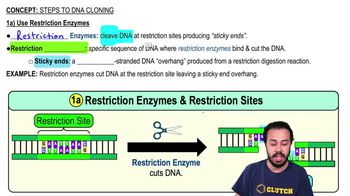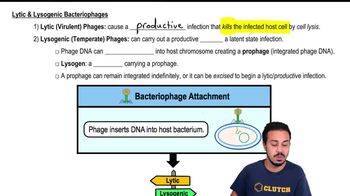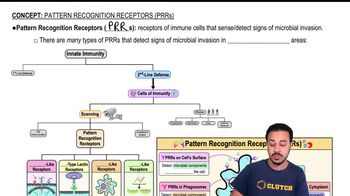Why are mutation and recombination important in the process of natural selection and the evolution of organisms?
Restriction enzymes were first discovered with the observation that
a. DNA is restricted to the nucleus.
b. bacteriophage DNA is destroyed in a host cell.
c. foreign DNA is kept out of a cell.
d. foreign DNA is restricted to the cytoplasm.
e. all of the above
 Verified step by step guidance
Verified step by step guidance
Verified Solution
Key Concepts
Restriction Enzymes

Bacteriophage Interaction

Foreign DNA Recognition

Two offspring cells are most likely to inherit which one of the following from the parent cell?
a. a change in a nucleotide in mRNA
b. a change in a nucleotide in tRNA
c. a change in a nucleotide in rRNA
d. a change in a nucleotide in DNA
e. a change in a protein
Compare and contrast the following terms:
a. cDNA and gene
b. DNA probe and gene
c. DNA polymerase and DNA ligase
d. rDNA and cDNA
e. genome and proteome
Match the following choices to the statements in questions 7 through 10.
a. antisense
b. clone
c. library
d. Southern blot
e. vector
DNA that hybridizes with mRNA.
Differentiate the following terms. Which one is “hit and miss”—that is, does not add a specific gene to a cell?
a. protoplast fusion
b. gene gun
c. microinjection
d. electroporation
The DNA probe, 3'-GGCTTA, will hybridize with which of the following?
a. 5'-CCGUUA
b. 5'-CCGAAT
c. 5'-GGCTTA
d. 3'-CCGAAT
e. 3'-GGCAAU
